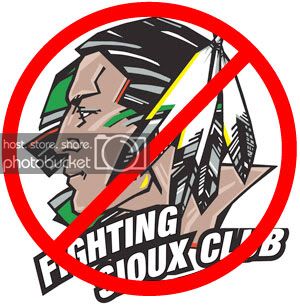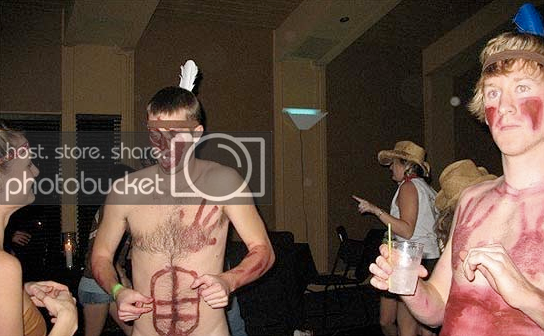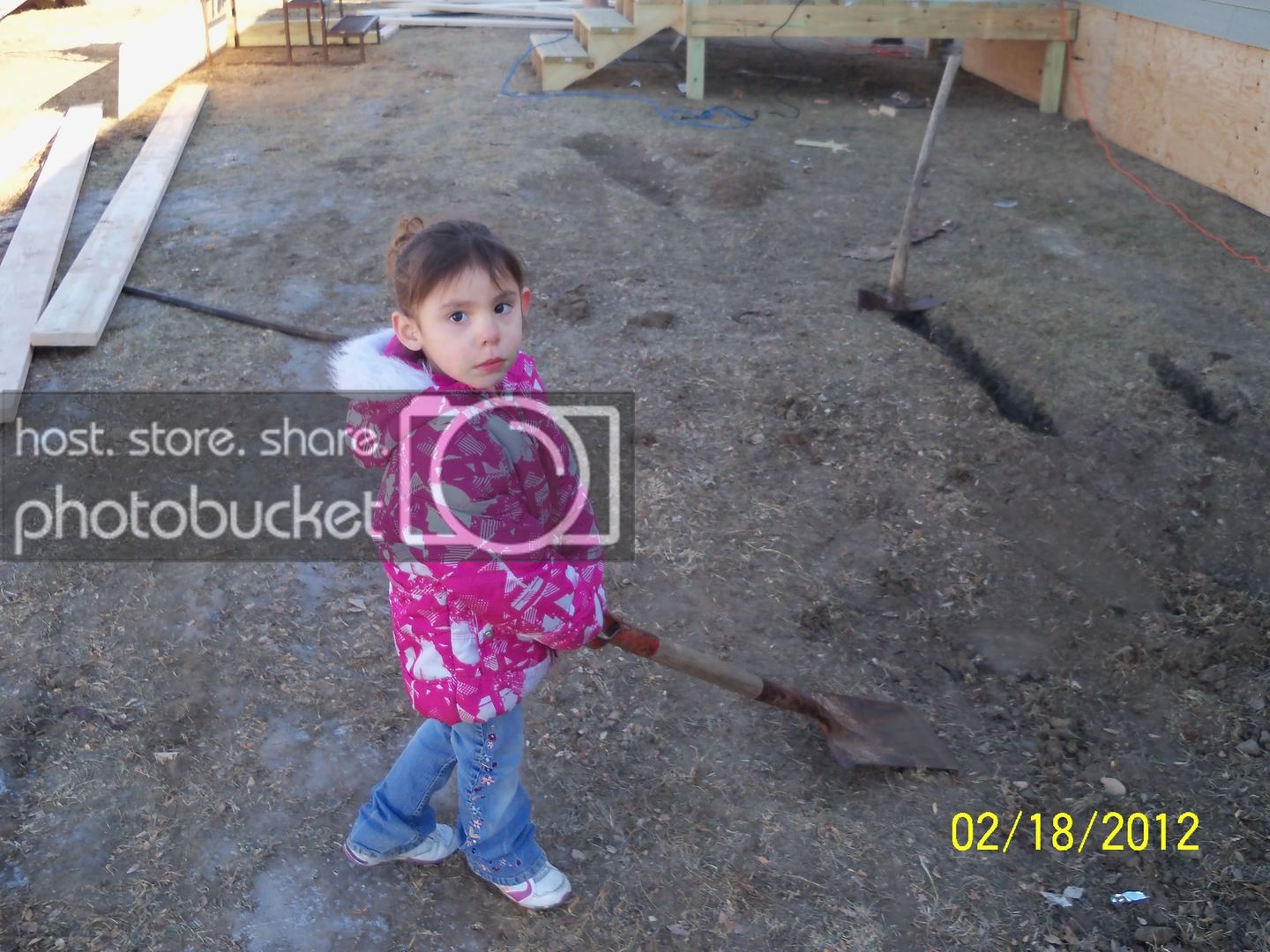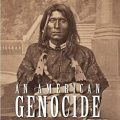( – promoted by navajo)
What does the epithet “Prairie RedSkins” have to do with the controversy around the University of North Dakota’s mascot, the “Fighting Sioux?”
It’s simple.
Racism.
Simply racism.
 Follow me from a 2009 Tribal Council Meeting on the Standing Rock Reservation where students testified about why they had dropped out of the University of North Dakota to recent news that the North Dakota legislature has effectively repealed a law it passed earlier this year that mandated that the UND keep the Fighting Sioux Mascot, bucking a 30+ year trend to to get rid of these disrespectful signs of school spirit. So now the mascot and team name is “in transition” (to avoid further NCAA sanctions).
Follow me from a 2009 Tribal Council Meeting on the Standing Rock Reservation where students testified about why they had dropped out of the University of North Dakota to recent news that the North Dakota legislature has effectively repealed a law it passed earlier this year that mandated that the UND keep the Fighting Sioux Mascot, bucking a 30+ year trend to to get rid of these disrespectful signs of school spirit. So now the mascot and team name is “in transition” (to avoid further NCAA sanctions).
How long did this thing going take to play out?
Decades. Decades during which American Indian students on campus were the subject of racist attacks while the university simultaneously built up its American Indian Studies program.
And to add intrigue to this story, there was a nefarious, Nazi-obsessed, big capitalist donor (read, casino owner) behind this controversy at its height.
And P.S. No, I’m not exaggerating about the Nazi obsession. This actually supports research suggesting that once you stereotype one group you’re more likely to stereotype other groups. So, the mascots actually increase stereotyping in general.
There is a long history of sports teams using American Indian mascots in this country, and another long history of activists convincing schools to stop this disrespectful practice. There is a good timeline”here of efforts to get rid of Indian mascots since 1968.
Here is a good summary of the issue. It is from an academic article that talks about “the activists” but then goes on to show the the historical and psychological accuracy of the arguments below:
Anti-mascot activists articulate many different arguments against the mascots. First, they assert that the mascots stereotype Native Americans as only existing in the past, having a single culture, and being aggressive fighters. Second, they hold that these stereotypes influence the way people perceive and treat Native Americans. Such imagery is seen as affecting Native American images of themselves, creating a hostile climate for many Native Americans, and preventing people from understanding current Native American realities, which affects public policy relative to Native Americans. Third, the activists state that no racial cultural group should be mimicked (especially in regard to sacred items/practices), even if such mimicking is “culturally accurate.” And fourth, they argue that Native Americans should have control over how they are represented (Davis, 1993,2002; King & Springwood, 2001a, 2001b; Pewewardy, 1991; Spindel, 2000; Staurowsky, 2000).

I have posted the references from the article at the end of the diary for your further research. Research does NOT support claims that these mascots are harmless, or respectful, or anything but hegemonic discourse that makes stereotyping seem natural.
Taunts and Eggs on the UND Campus
I went out to the Standing Rock Reservation in 2009 and ended up sitting in on a Tribal Council meeting. The Tribal Chairman at the time, Ron His Horse is Thunder, was ardently against continuing the use of the Mascot, as were most of the Tribal Council members. The Tribal Council had voted to continue objecting to the use of the mascot in 2007. In 2009 it was voting on whether to hold a reservation-wide vote.
As I was watching the normal business of the Tribe being discussed, a line of former UND students began emotional testimony about why they had dropped out of school. They all dejectedly described how they had been harassed on campus by white students, had eggs thrown at them, and sometimes had been physically attacked. They all had also been called “prairie RedSkin” on several occasions.
Prairie RedSkin? I really thought I hadn’t heard that correctly. What must it feel like to be called that while you’re trying to get yourself an education to improve your lot in life????? It was jaw dropping.
What the HELL was THAT all about?
Racism. Racism inflamed by money. More specifically, big donor Ralph Englestad’s threat to withdraw $100 million in funding for a new stadium, which he had engraved with hundreds of Fighting Sioux mascots.
Although there had been tensions on campus around the issue for a couple of decades, they became inflamed at the turn of the 21st Century, and the NCAA finally stepped in in 2005:
The NCAA instituted its policy in 2005, initially listing 18 schools whose nicknames and/or mascots were “hostile or abusive” toward native Americans. Schools that continued to use the nicknames, or hostile or abusive images, would not be able to host NCAA postseason events or use the images at an NCAA postseason event.
North Dakota is the only school from that initial list that has not already changed its nickname, mascot and/or logo.
The university had agreed to retire its nickname and logo in mid-August, but the Legislature pre-empted those plans by approving a bill in March that requires UND to keep them.
Nickname supporters flooded lawmakers with emails at the time, and Gov. Jack Dalrymple signed the measure only a few hours after he received it.
That legislation is what has just been repealed.
A little more on what happened after the initial 2005 NCAA action.
Here’s an excerpt from a recent Sports Illustrated article:
…UND filed a lawsuit challenging how the association had reached its decision. In an October 2007 settlement, the university agreed to retire its nickname and logo if it could not get approval from North Dakota’s two largest Sioux tribes, the Standing Rock Sioux and the Spirit Lake Sioux, for their continued use.
The Spirit Lake Sioux tribe endorsed the nickname in a subsequent referendum, but the Standing Rock Sioux tribal council declined to support it or call a reservation referendum on the question.
Robert Kelley, UND’s president, said he had spent about half his time as president on the nickname and logo issue since taking the job in 2008. In the last year, the issue has demanded almost three-quarters of his time, Kelley said.
Repealing the law would “support our student athletes by removing sanctions (and) other restrictions that complicate the future of UND athletics,” Kelley said.
The 2009 vote on Standing Rock came out of the 2007 suit. How could it vote in favor of it after that testimony? Too many white students were acting out the disrespect and racism embodied in the use of the Fighting Sioux mascot.
But lets go back a bit farther to who the hell this donor was (he died in 2002).
A Nazi-obsessed Donor
From a 2001 Salon.com article:
Enter Mephisto, dasher boards left. Ralph Engelstad is a Las Vegas casino owner and a major donor to the University of North Dakota, where he was a goalie in the late ’40s. He’s also a guy who’s been fined $1.5 million by the Nevada Gaming Control Board for damaging the reputation of the state by holding, in two separate years, private Hitler’s Birthday parties at his casino, complete with a swastika cake, German food and marching music, bartenders wearing T-shirts with the words “Adolph Hitler European Tour 1939-45,” and a life-size portrait of Hitler inscribed “To Ralphie from Adolph, 1939.” He says he despises Hitler, and that the parties were merely “spoofs” meant to celebrate new purchases for his collection of Nazi memorabilia.
Yeah, right….
Here’s an excerpt of a letter he wrote to UND in 2000, yes almost 12 years ago, about the mascot issue:
If the logo and slogan are not approved by the above-mentioned date, I will then write a letter on December 30, 2000, to all contractors and to everybody associated with the arena, canceling their construction contracts for the completion of the arena. I am a man of my word, and I will see to it that a settlement is made with all subcontractors, with anyone who has purchased prepaid advertising. I will refund money to all ticket holders and abandon the project. It would then be left up to you if you want to complete it, with money from wherever you may be able to find it.
I have spent, as of this time, in excess of $35 million, which I will consider a bad investment, but I will take my lumps and walk away.
As I am sure you realize, the commitment I made to the university of North Dakota was, I believe, one of the 10 largest ever made to a school of higher education, but if it is not completed, I am sure it will be the number one building never brought to completion at a school of higher education, due to your changing the logo and the slogan.
You need to think how changing this logo and slogan will affect not just the few that are urging the name change, but also how it will affect the university as a while, the students, the city of Grand forks, and the state of North Dakota.
If I walk away and abandon the project, please be advised that we will shut off all temporary heat going to this building, and I am sure that nature, through its cold weather, will completely destroy any portion of the building through frost that you might be able to salvage. I surely hoped that it would never come to this, but I guess it has.
It is a good thing that you are an educator because you are a man of indecision, and, and if you were a businessman, you would not succeed, you would be broke immediately.
Please do not consider this letter a threat in any manner, as it is not intended to be. It is only notification to you of exactly what I am going to do if you change this logo and this slogan.
In the event it is necessary to cancel the completion of the arena, I will then send notification to anyone who is interested, informing them of the same, and laying out to them all of the facts and all of the figures from all of the meetings that led me to make this decision.
Your lack of making a decision has hung over our heads too long, and we can’t go on with it any further.
It is your choice if you want to put hundreds of construction workers out of a job, and deprive the local businesses of Grand forks of the income they are receiving f4rom the construction of the arena.
Always sticking to the economic blackmail, as is typical of the right.
By now it should be clear that the Fighting Sioux mascot was directly related to harassment of American Indian students at the University of North Dakota, and that the racism that it promotes was directly related to the frequency of the “prairie RedSkin” epithet. The example I cited from the testimony wasn’t the only instance of this kind of racial harassment. Similar incidents, including hateful emails, are documented in articles describing tensions in the early 2000s.
So, if you look at the UND website, you’ll see an overlay about the transition, which seems to have taken place immediately after the Nov 10 vote by the North Dakota legislature.
Can we now work on retiring the epithet “prairie RedSkin” too? I’m not naive enough to believe that nobody will hear that again, but with this mascot issue gone, I’m hoping that there will at least be LESS harassment of American Indian students.
Here are the references from that article:
REFERENCES
American Indian opinion leaders: American Indian mascots. (2001, August 7). Indian Country Today Retrieved May 22, 2002 from http://web.archive.org/web/20040301122612/http://www.indiancountry.com/?43
Berkhofer, R. F. (1978). The White man’s Indian: Images of the American Indian from Columbus to present. New York: Vintage/Random Rouse.
Bird, S. E. (Ed.). (1996). Dressing in feathers: The construction of the Indian in American popular culture. Boulder, CO: Westview.
Brown et al V. Board of Education of Topeka et al. (1954) 347 U.S. 483.
Clark, D. A. (2002). Someone inside me, there is a memory of my grandfathers:Mis-educated representations of “Indians, those symbolic insiders.” Unpublished manuscript.
Coombe, R.J. (1998). Embodied trademarks: Mimesis and alterity on American commercial frontiers. Cultural Anthropology, 11(2), 202-224.
Davis, L. R. (1993). Protest against the use of Native American mascots: A challenge to traditional American identity. Journal of Sport & Social Issues, 17(1), 9-22.
Davis, t. R. (2002, Summer). The problems with Native American mascots. Multicultural Education, 9(4) 11-14.
Davis, L. R., & Rau, M. (2001). Escaping the tyranny of the majority: A case study of mascot change. In C. R. King & C. fl Springwood (Eds.), Team spirits: The Native American mascot controversy (pp.221-238). Lincoln: University of Nebraska Press.
Deloria, P. J. (1998). Playing Indian. New Haven, CT: Yale University Press.
Farnell, B. (in press). The fancy dance of racializing discourse. American Indian Quarterly.
Fenelon, J. V. (1999). Indian icons in the world series of racism: Institutionalization of the racial symbols of wahoos and Indians. Research in Politics and Society (6): 25-45.
Goldberg, B. (2001).Bias:A CBS insider exposes how the media distort the news. Washington, DC: Regnery Publishing.
Green, R. (1988). The tribe called wannabee: Playing Indian in America and Europe. Folklore, 99, 30-55.
Greenfeld, L. A.& Smith, S. K. (1999). American Indians and crime. Washington, DC:Bureau of Justice Statistics.
Grounds, R. (2001, June). Tallahassee, Osceola, and the hermenuetics of American place-names. Journal of the American Academy of Religion, 69(2), 287-322.
Hooks b. (1992). Black looks: Race and representation. Boston: South End Press.
Jaimes, M. A. (1992). The state of Native America: Genocide, colonization, and resistance. Boston: South End Press.
King, C. R. (2001). Uneasy Indians: Creating and contesting Native American mascots at Marquette University. In C. R. King & C. F. Springwood (Eds.), Team spirits: The Native American mascot controversy (pp. 281-303). Lincoln: University of Nebraska Press.
King, C. H. (2002). Defensive dialogues: Native American mascots, Anti-Indianism, and educational institutions. SIMILE: Studies in Media and information Literacy Education, 2(1). Retrieved from – Dead link > www.utpjournals.com/jour.ihtrnl?lp=simile/issue5/king1.html
King, C. H. (in press). Arguing over images: Native American mascots and race. In H. A. Lind (Ed.), Race /gender~media: Considering diversity across audiences, content, and producers. Boston: ABLongrnan.
King, C. R., & Springwood, C. F. (2000). Fighting spirits: The racial politics of sports mascots. Journal of Sport & Social Issues, 24(3): 282-304.
King, C. R., & Springwood, C. F (2001a). Beyond the cheers: Race as spectacle in college sports Albany: State University of New York Press.
King, C. R., & Spriagwood, C. F (Eds.). (2001b). Team spirits: The Native American mascot controversy Lincoln: University of Nebraska Press.
KoIb, J. J. (2001). Indian mascots: Activists say change needs to begin at home. American Indian Report 11(3): 24-25.
Mihesuah, D. A. (1996). American Indians: Stereotypes and realities. Atlanta, GA:
Clarity Press.Nagel,J. (1995). American Indian ethnic renewal: Politics and the resurgence of identity. American Sociological Review, 60, 947-965.
Pewewardy, C. D. (1991). Native American mascots and imagery: The struggle of unlearning stereotypes. Journal of Navajo Education, 9(1), 19-23.
Pewewardy, C. D. (2001). Educators and mascots: Challenging contradictions. In C. R. King & C. F Springwood (Eds.), Team spirits: The Native American mascot controversy (pp. 257-278). Lincoln: University of Nebraska Press.
Pewewardy, C. D. (2002, May). From subhuman to superhuman: Images of First Nations people in comic books [Electronic version). Studies in Media & Information Literacy Education, 2(2), Retrieved from http://web.archive.org/web/20020909233516/http://www.utpjournals.com/jour.ihtml?lp=simile/issue6/Pewewardyfulltext.html
Rosenstein, J. (1996). In whose honor? American Indian mascots in sports [Film]. (Available from New Day Films, 22-D Hollywood Avenue, Ho-ho-kus, NJ, 07423)
Shively, J. (1992). Cowboys and Indians: Perceptions of western film by American Indians and Anglos. American Sociological Review, 57(6), 725-734.
Sigelman, L. (1998). Hail to the Redskins? Public reactions to a racially insensitive team name. Sociology of Sport Journal, 15(4), 317-325.
Slapin, B., & Seale, D. (1998)-Through Indian eyes: The native experience in books for children. Berkeley, CA: Oyate.
Spindel, C. (2000). Dancing at halftime: Sports and the controversy over American Indian mascots. New York: New York University Press.
Springwood, C. F. (2001). Playing Indian and fighting (for) mascots: Reading the complications of Native American and Euro-American alliances. In C. R. King & C. F. Springwood (Eds.), Team spirits: The Native American mascot controversy (pp. 304-327). Lincoln: University of Nebraska Press.
Springwood, C. F. (in press). I’M an Indian too! Claiming Native American identity, crafting authority in mascot debates. American Indian Quarterly.
Stapleton, B. (2001). Redskins: Racial slur or symbol of success? San Jose, CA: Writers Club Press.That
Staurowsky, E. J. (1998). An act of honor or exploitation? The Cleveland Indians’ use of the Louis Francis Sockalexis story. Sociology of Sport Journal, 15(4), 299-316.
Staurowsky, E. J. (2000). The “Cleveland Indians”: A case study of American Indian cultural dispossession. Sociology of Sport Journal, 17(4): 307-330.
Trainor, D. J. (1995). Native American mascots, schools and the Title VI hostile environment analysis. University of Illinois Law Review, 5, 971-997.
Journal of Sport & Social Issues, Volume 26, No.4, November 2002, pp. 381-402



…this issue.
We Indians have two problems regarding visibility. The first is that, except as symbols and historical examples, we are mostly invisible. Whether we live in urban areas or are rezidents, our issues go unnoticed even by much of the progressive community of which many of us are a part. The other is represented by what you have written here; that is, too often when we ARE visible, we are mere caricatures, and not just as team mascots.
I have a special interest in this since my high school’s teams – Arvada High School in the Denver suburbs – were the “Redskins,” with a racist logo to match and a wa-wa-wa guy dressed faux-Plains Indian style “dancing” to a drummer from the school band during athletic contests. Two of us, both varsity lettermen, tried to get the name changed in 1963, and were roundly ridiculed for it. It finally was changed in 1992 after a huge battle that included a vote of students, alumni and residents near the school. They switched to “Reds” and later “Bulldogs.” I am always glad to see another of these hideously in-our-face throwbacks tumble into oblivion.
But there are still many around. And some people still think it’s OK. Your headline, for instance, is filled with asterisks because people rightly are appalled when “ni**er” is used as an epithet. No teams are called the Omaha “Ni**ers” or the New Orleans “Spics” or the Portland “Kikes.” But you could have put “Redskins” into that headline and far fewer people would have flinched than if one of those other epithets had appeared fully spelled out. Indeed, the name Washington Redskins continues to be defended as perfectly all right.
The use of these disrespectful names and images for athletic teams, with the remaining resistance to change in some quarters, is certainly not the most important issue for Indians. But it is a reflection of those deeper issues that much of society clearly wishes to ignore.
It took ages to get the NCAA on board with putting the screws to colleges that wouldn’t change their offensive mascots. But it finally did. The fight, however, continues at secondary schools around the country, with a good deal of defiance by the leaders of the communities in which they exist. May the day come when they are all gone.
is for us to control our own history: for too long others have defined our history and told us what is important. The elder who “encouraged” (I came from a tradition that when the elders “encourage” you, you do it) me to start writing about history strongly emphasized that Indians had to write their own histories, and they had to control the publication of these histories.